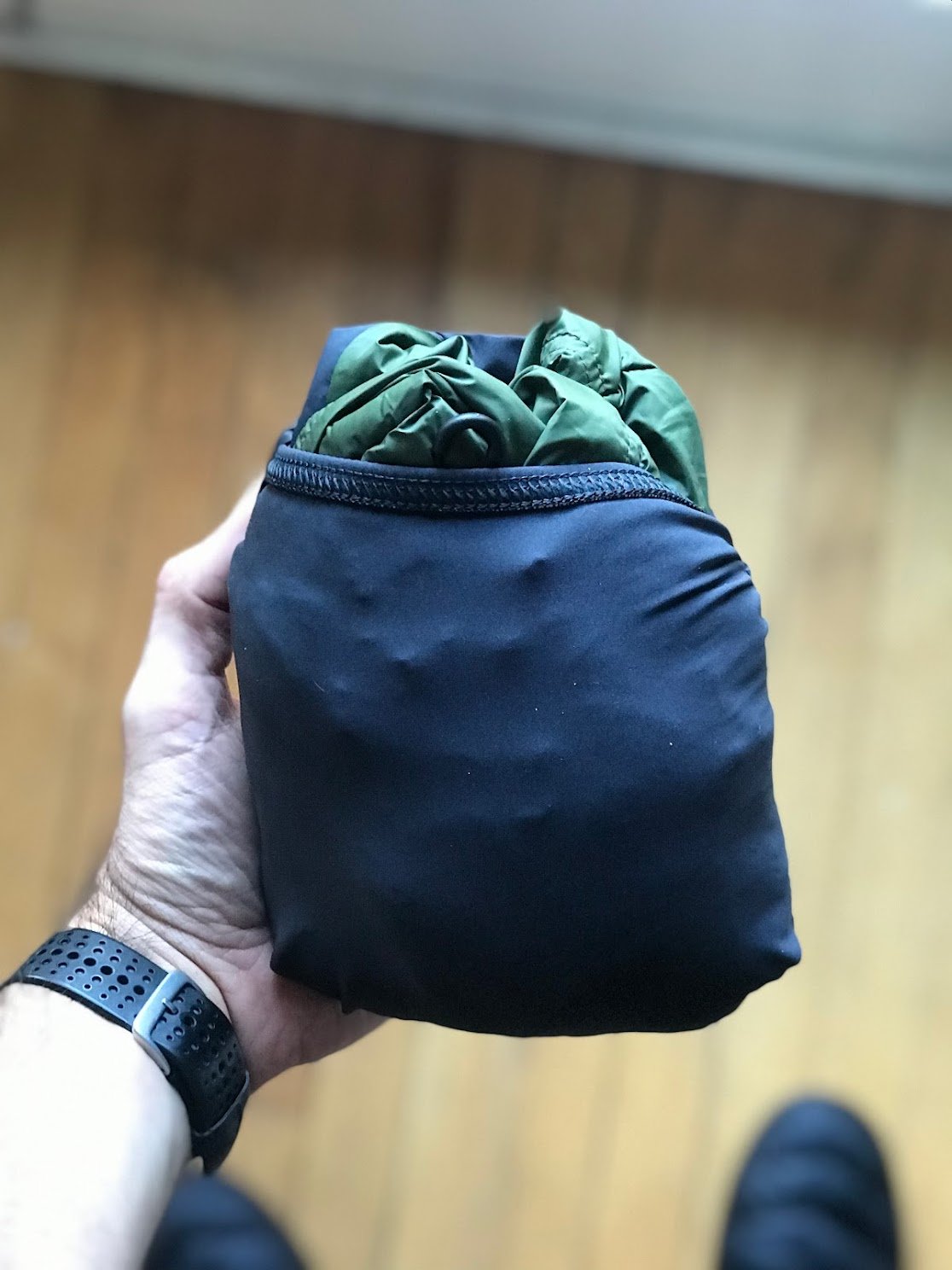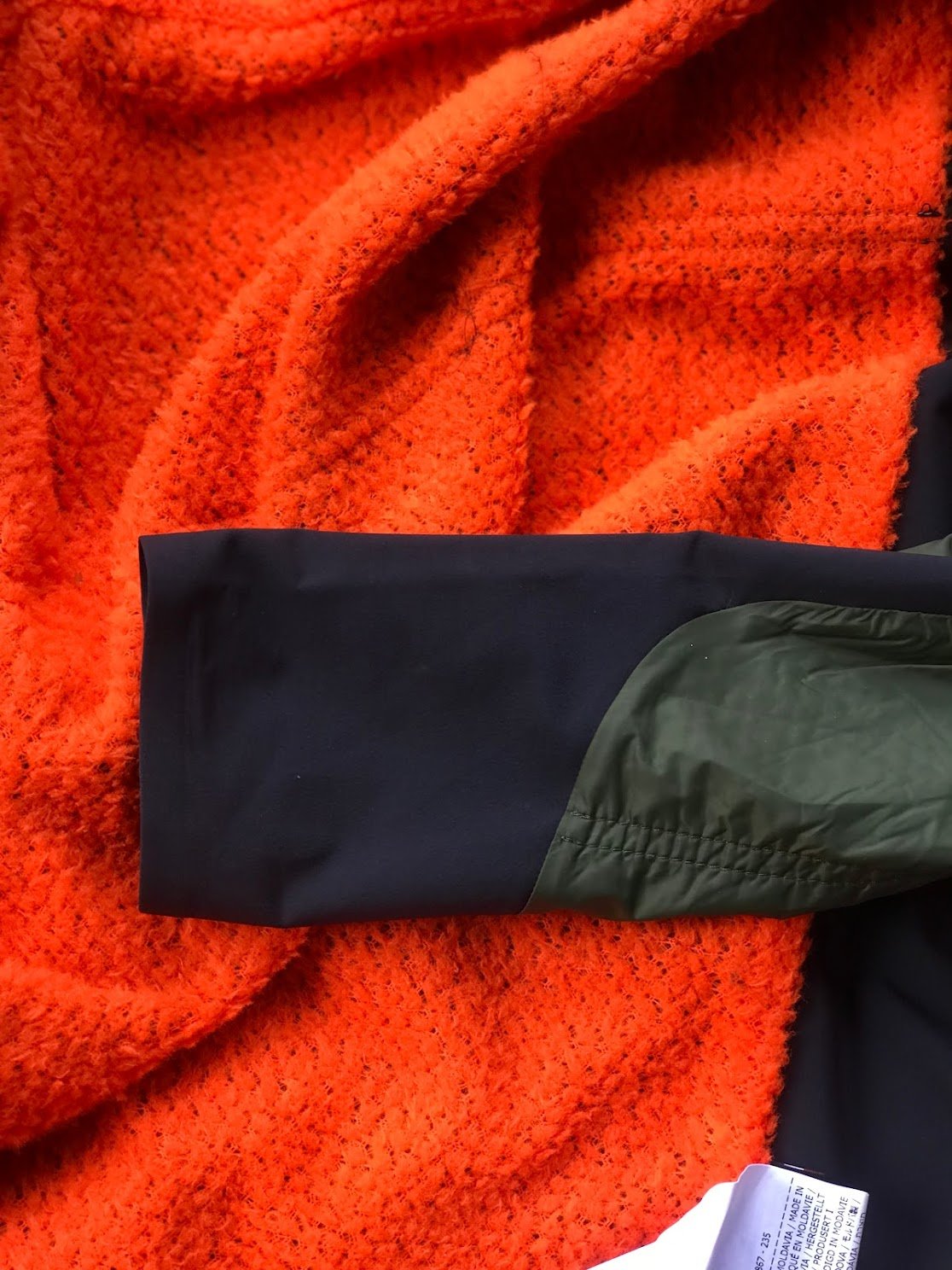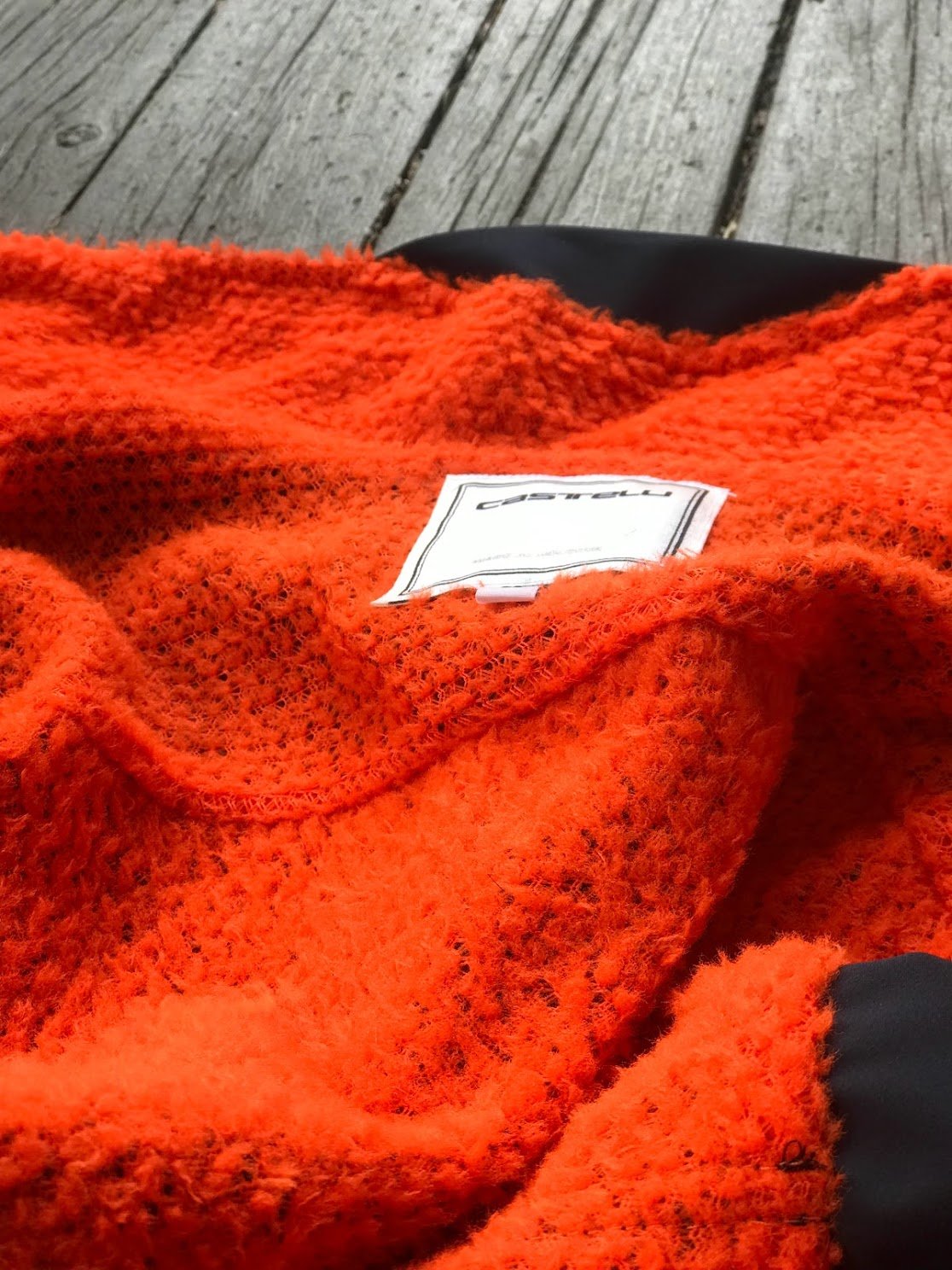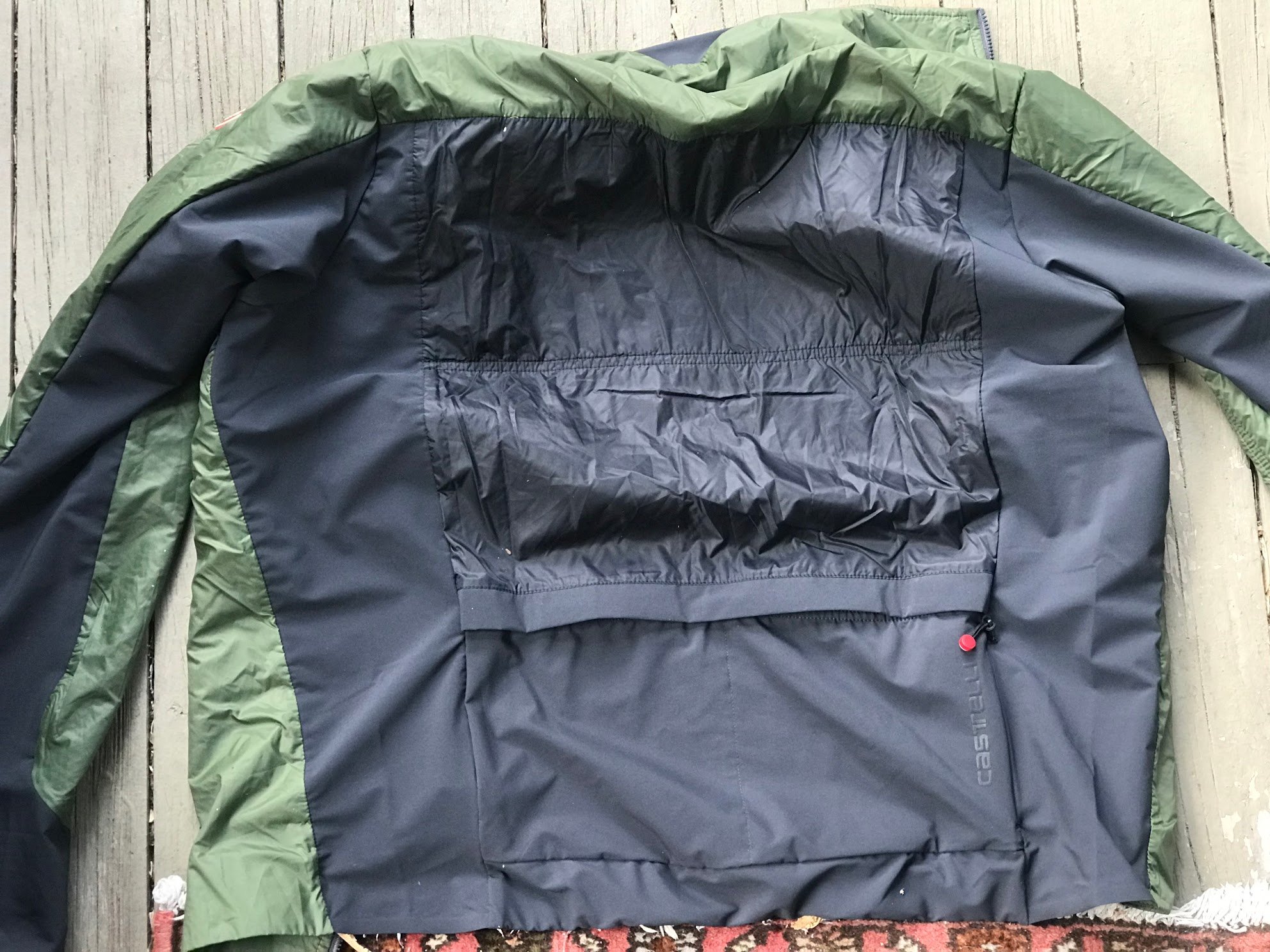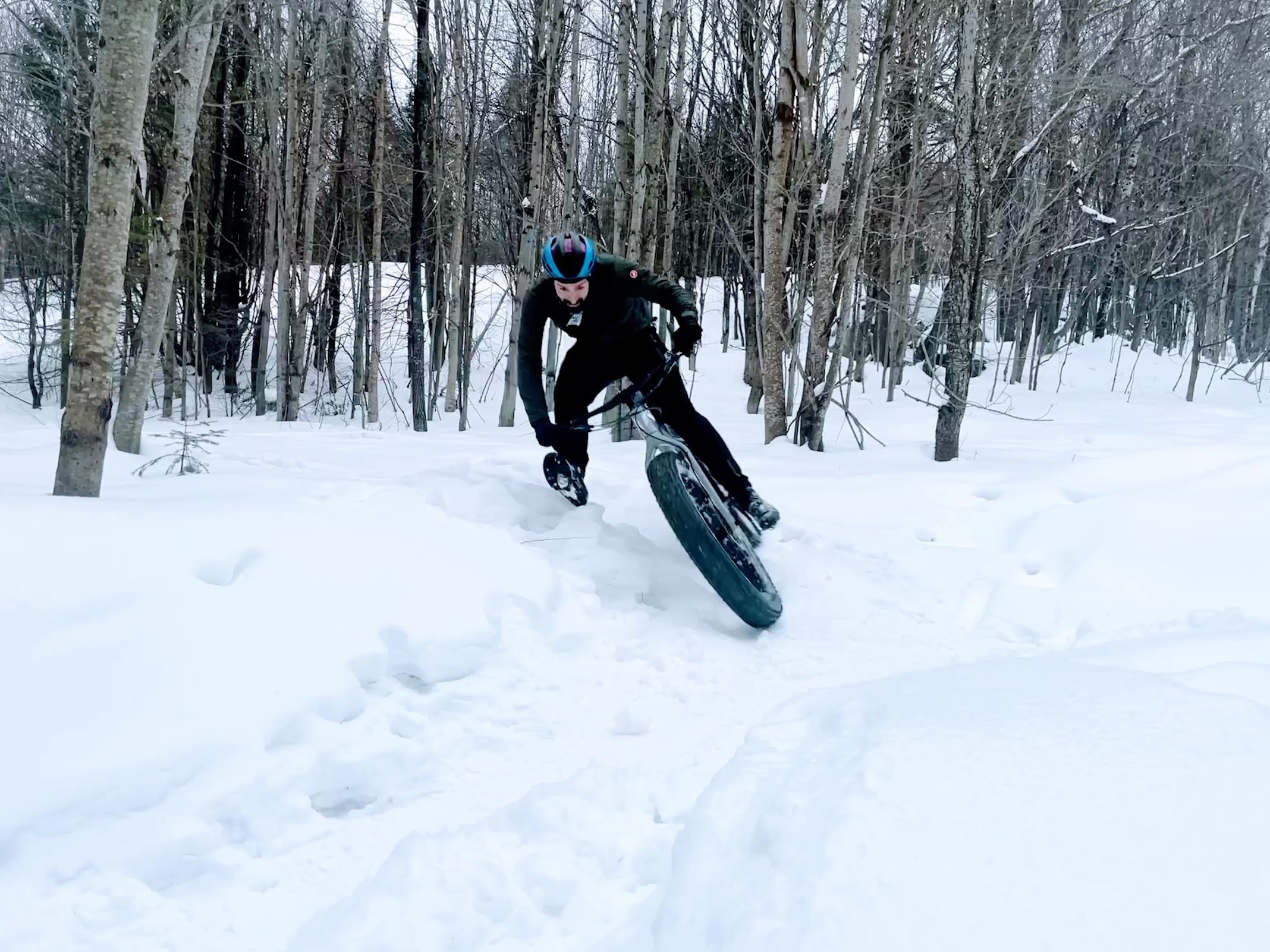MATTER: Castelli’s Unlimited Puffy Jacket
In recent years, as I’ve infused more overnight and multi-day rides into my cycling life than when I was racing and travelling to far-away places, I’ve enjoyed the challenge of learning how to scale and refine my kit choices across three seasons. While the weather is warm, the challenge isn’t terribly difficult to meet. But when there’s possibility or likelihood of riding in low double and single digits (Celsius), and I’m trying to travel as light as possible, I’ve felt myself missing a key piece: a puffy jacket that was suitable for on and off the bike. Wouldn’t that be cool‽
In September, 2021, the universe answered my call. Specifically, Castelli did. As I perused the new fall collection to work out which pieces to request for testing, feedback, and sharing information about with all of you, the Unlimited Puffy jumped off my screen.
YES! They’ve done it!
From the photo details I saw, the jacket was intriguing. Foremost, it seemed to use a novel interior insulation layer, a lofty fleecy structure. The exterior looked light; how packable would it be? Windproof? How warm? What about durability?
I requested a LARGE Puffy, the same size I wear for Castelli’s other jackets, like the Perfetto, Alpha RoS2, and Elemento. It arrived just in time for a cold, windy all-road ride, time to start testing! What followed surprised me, prompting some back and forth with Steve Smith at Castelli, and a whole bunch more time in the jacket through Fall and Winter 2021-22.
What the heck?
The moment I pulled the Puffy out of the box I knew I was holding something unique. This wasn’t a variation on a theme; it was a whole new composition. Everything about the jacket felt unfamiliar, starting with its weight. Compared to the phenomenal Alpha RoS 2, the Puffy was in a league of its own: feathery. I wondered, how small can I crush this thing up? Small.
The jacket’s exterior fabric reminded me of my Patagonia puff jacket’s outer, but it was thinner. The combination of thin, stretchy fabric along the sides of the torso, underside of arms, and cuffs made intuitive sense, in conjunction with the more ‘crinkly’ wind-resistant material, which Castelli describes as “coated windproof microfiber woven outer shell with DWR treatment”. This means the fabric is coated to repel water, and this treatment can be renewed periodically using aftermarket products. The stretchy fabric is Nano Flex, which Castelli deploys to great effect across a broad range of pieces. The cool thing about Nano Flex is that its water repellency is structural, not a coating, so it retains its function even in high-friction areas and wash after wash.
Things got really freaky when I looked closely at the jacket’s insulation. This “Polartec® Alpha® Direct insulation layer for maximum loft with minimum bulk” is ‘direct’ because it’s an insulation structure that isn’t contained between fabric layers. It sits directly against the body and whatever base-layers we have on. Some manufacturers are actually making ‘naked’ Alpha Direct pieces for general use, foregoing any wind protection layer - shell jackets can be used over top as needed.
The idea is with the Unlimited Puffy is to remove unnecessary layers of material, afford the rider maximum tuneability with inner layers, and create the most effective moisture management system possible while also protecting against wind, and to a degree, water. The insulation’s structure creates loft against the body, holds warm air, and allows vapour to escape to and through the shell/outer fabric. Would the insulation itself retain moisture? How wind-resistant would the shell fabric be? Honestly, it was impossible to tell how warm the jacket would be while holding it.
Thermal regulation properties aside, I was interested to see how the Castelli team approached pockets. Two spacious Nano Flex pockets grace the back, with a nice and easy to access zipper pocket integrated into the side of the right pocket, with a subtle reflective Castelli logo running along its length. A Napoleon pocket is placed on the left chest. Little touches, like a Nano Flex panel behind the neck, cowl for the upper section of the zipper, and ‘felt’ Castelii scorpion logo on the left shoulder round out a thorough, thoughtful, carefully designed and constructed jacket. I couldn’t wait to find out what riding in it felt like.
The Harshest Shakedown Possible?
November 27, 2021, Ottawa, Canada. Perhaps not the use-case the Castelli team had in mind for the Unlimited Puffy, I set out from home thinking I might be making a mistake. I donned their Flanders Warm base-layer (which is sort of shockingly excellent) and a medium-weight merino base layer under the Puffy, along with the new Polare 3 bib-tights, Espresso GT gloves, and Estremo shoe-covers. It was a 75% - 80% humidity day (not cute), about -9C when I left home. If these conditions were not enough, wind speed was around and above 28km/hr! I mean, c’mon. Gnarly.
The wind was destroying the thin strip of forehead exposed between my hat and glasses as I rode North, leading me to wonder whether I was making a mistake riding outside; only my desire to learn what the Puffy could do drove me on. And my stubbornness. As my forehead and the rest of my face adjusted to the steady onslaught of heat-stripping wind, I didn’t feel it getting through anywhere else. What I did sense was a loud flapping, as wind battered the fabric atop my shoulders. What the heck, that’s a new one! I tried to ignore it as I rode on, and naturally, the sound faded as my wind exposure improved. But over the 6 hours out on the bike, I couldn’t help but wonder, ‘Is this jacket only for slowish speed riding? Did I get it in too big a size?”
Ultimately, I only ever felt wind penetrate the front of the jacket at 55kph on that ride, which I was pleasantly surprised by. It was warm, no doubt, but with such thin outer fabric, would it be durable? Is it the sort of jacket folks might want for daily commuting, or would that be destructive? Would it be best-suited to sporadic use, a key item to have along for bike-packing, touring, weekend riding trips? I sent Steve Smith an email with a few questions, in an effort to stress-test my perceptions and assumptions about the jacket.
How it Works, What it’s Good For
Castelli developed the Puffy to fit into their Unlimited range of gravel kit. Aero performance was not a priority; packability, warmth, moisture management, wind protection, and casual aesthetics for off-bike time were. The idea was to produce a jacket that would be polyvalent, because going long, on gravel or whatever, demands flexibility and adaptability.
I’ve yet to ride in conditions the Unlimited Puffy wasn’t warm enough for. Given its designated temperature range is 2C - 14C, one might think going sub-zero would be pushing it. The fact is, the Puffy can be used effectively WAY colder than 2C, overlapping the use-range of the Alpha RoS 2. This is somewhat mind-bending, given the significant weight difference between the two jackets; I think the key differentiating factor at play is moisture management.
Simply, the Puffy moves vapour away from the body better than anything else I ride in that is also very wind-proof. The Alpha RoS 2 is warmer at low-intensity output, but as increasing volumes of vapour need to move through the jacket, it struggles to vent through its outer fabric as quickly as the Puffy can. Ice can form on the exterior of the Alpha; when accumulation exceeds evaporation, and body heat production drops, like when descending. The Unlimited Puffy simply can’t accumulate as much moisture between insulation and exterior, so it’ll often look slick with moisture on the outside when evaporation isn’t keeping pace with moisture venting. The good news is that the fabric doesn’t really ‘want’ to hold this water, so it doesn’t take much time for it to dry out.
Companies like Castelli produce a myriad of jacket and thermal jersey styles because this is all a matter of compromise and priorities; there’s no one ideal piece for a given rider to cover a broad range of cold conditions, and the Alpha is certainly going to be the better option than the Unlimited Puffy and numerous other models if it’s both cold AND raining. If it’s cold and dry, however, one’s optimum will depend on intensity level, wind exposure., and riding speed. Versatility in a jacket comes down to the degree to which we can adapt internal layers to span a broad use-range, and the importance we put on being and feeling dry, which should vary by season. After all, moisture evaporating off the skin in dry summer heat serves to cool us.
A potential co-benefit of Castelli’s Polartec’s Alpha Direct insulation use, being fluffy, is that it won’t necessarily need to be separated from your skin with a base-layer. Lots of other fabrics used for jacket interiors feel clammy and gross against the skin, but I speculate the Puffy will work well until sweat-rate gets high enough to keep the AD structure from wicking and transporting moisture away. Recall, the Puffy was conceived as a gravel jacket, easily packable and versatile across seasons. For summer overnight-ride use, I can easily see myself packing it while wearing a short-sleeved jersey, and light arm-warmers, to support wicking and moisture transfer. Based on my experience thus far, the Puffy over a summer jersey and warmers would be warm enough down to lows around freezing. The wind protection it provides would be particularly valuable when riding in humidity up close to 100%, which is common in my region from late summer through early winter. Bare arms against the jacket’s interior will be comfortable, which means leaving arm-warmers at home will be an option as well.
Intensity Factors: Riding Styles
Given the time of year I started riding in the Puffy, my lens for testing was immediately cold-weather performance, not the intended gravel use-case Castelli had in mind. While I initially thought the jacket might be suited to a relatively narrow use-range, I immediately learned that wasn’t at all the case. The question became: where does the Puffy excel, and where does it struggle? Riding intensity is at the core of the matter.
On the topic of intensity, it’s important to distinguish road riding from off-road in the cold. Generally, riding on paved or unpaved roads brings the highest degree of wind exposure, and the steadiest power output. It’s relatively easy, when geared well, to constrain power output and keep body heat production constant. The name of the game is to keep moisture accumulation on and close to the skin minimal, and by combining steady effort and wind exposure it’s actually relatively easy to strike a balance of moisture production and evaporation. For example, when I rode my Winter Solstice 200 in the Perfetto jacket, I retained zero moisture all day. I was juuuuust warm enough while in the worst wind, which was responsible for evaporating my body vapour. So, when we dress right for a given intensity in the wind, we’re warm enough, and not damp. Nailing it for relatively high intensities involves a significant degree of venting, and not a lot of insulation. So, if/when we have to stop, and our heat production drops, we lack insulation to retain precious heat. If dry, this isn’t such a bad scenario, provided we can bring body temp back up before long. If we’re wet, the rate at which we chill is far more rapid, which can create compounding issues, like immobilized hands required to fix a bike, then ride again and bring heat up again. So we need to do what we can to stay dry; sometimes it’s imperative.
In contrast to road riding, trails in the winter might seem easier to dress for, and it often actually is. When energy output swings up and down over rolling terrain, for example, minimal layering will work well, because climbs are short enough to drive body heat and sweat-rate up a lot, while descents are too short to strip much heat away and/or chill accumulated moisture. This scenario, which is totally ‘normal’ for lots of cold-weather off-road riders, involves lots of heat production, and no extended periods of the opposite, like alpine descents. So, while things are going to plan, the riding’s intensity is phased and vigorous enough to overcome the downside of moisture accumulation. We can ‘afford’ to get and stay damp in this scenario, assuming we don’t suffer a mechanical problem, a serious crash, or whatever else that might stop us or slow us down considerably for any length of time. Low insulation, combined with damp clothing, is great until it isn’t. Reminds me of the Mike Tyson quote: “Everyone has a plan until they get punched in the mouth.”
I’ve done many hours of fat biking this winter, mostly on technical singletrack trails with lots of rolling elevation change. I’ve experimented with the Unlimited Puffy over numerous rides in the woods, and have been surprised to find that I need very little base-layering to feel comfortable. The thing is, I’m not experiencing dampness in my base-layers with the Puffy, and the jacket’s Polartec insulation has ALWAYS been dry whenever I check it mid and post-ride. At the same time, the microfiber exterior of the jacket has often been saturated, and even iced-up. This occurs when air circulation over the exterior is insufficient to carry the moisture away, which seems to almost be an off-road specific phenomenon (I’ve experienced this while using loose internal layers and a wind-shell in the winter on snirt rides). And it’s important to note that when I’ve transitioned from intense singletrack to more steady and lower-intensity terrain, the jacket’s microfiber has dried out. That’s the cool thing about pumping body heat out; it’ll facilitate evaporation when our sweat-rate drops. During a recent ride, I went from wet on the outside, warm and dry on the inside, to dry throughout by the time I got home.
The Hybrid Approach: Is it Better?
For winter trail riding, a hybrid approach to upper-body protection is common, comprised of breathable layers and an insulating jacket stashed on-board to put on while stopped. This is an old-school approach; folks have been relying on sweaters and other breathable layers and no shells for aerobic activities in the woods for ages. After years of getting smashed by wind out in the open on roads, it’s easy to forget how much less wind protection is required in the forest.
Since the Unlimited Puffy is very compactly packable, I figured I ought to experiment with riding trails in the new Fondo 2 FZ jersey, and the Puffy in my handlebar bag. The sheer volume of body vapour to clear seems to exceed what the Puffy can accomplish at low wind speeds, so bringing it along to put on when we stop for any length of time or face any extended wind exposure struck me as a sensible adaptation. The ride above was at -12C, and involved singletrack to start, then a decent haul on rail-trail to access more singletrack. In the woods I was more than warm enough, accumulating moisture with my two base-layers under the Fondo, while in the wind I could have asked for more protection. My Puffy wasn’t easily accessible in my handlebar bag (that’s a pair of overmitts in the white sac strapped on top in the photo), and I figured I’d evaporate off some moisture if I just plodded on. This worked out fine, and I wound up feeling like I probably should have only worn one base-layer under the Fondo, and made the Puffy more accessible.
The incredible thing about this experiment is that my internal layers were more damp at the end of the ride wearing the thermal jersey than with the Puffy jacket. So the thermal fabric, while permeable, wasn’t able to clear as much moisture as the Alpha Direct insulation can as it moves vapour to the jacket’s shell. When the ride ended I felt ‘dry’ - a testament to the Flanders Warm base-layer - but I wasn’t. Both base-layers were damp, and my Fondo jersey was verging on saturated. While producing heat, no problem. But again, feeling and being dry are two different things, and when things go wrong, we need to actually be dry.
The obvious tweak one might suggest would be to drop down to one base-layer for the same conditions and ride, and clear more moisture. BUT, this ride involved a decent span of rail-trail and wind exposure. Maybe it would work ok, maybe it would be cold enough to affect hand warmth .Sort of dicey. I lean away from the old-school layering approach for this sort of riding because its unrealistic to expect folks to have PhDs on cold-weather kit combos. A VERY small proportion of folks will ride frequently enough to look at the weather and select the ideal combination of pieces. And, weather is variable across rides. Throwing an insulating jacket on over top of damp layers might feel like a great move in the moment, but all it really does is delay the inevitable if intensity doesn’t come back up: getting cold.
Lock-out
Here’s the key take-away about the Puffy’s function versus any sort of permeable thermal layer we might use for high intensity riding in the cold: when a thermal/permeable outer layer takes on moisture, it becomes a source of dampness. Meaning, your insulating base-layers become sandwiched between your body (moisture source) and your outer layer (also moisture source). As your intensity drops, even if your inner layers were drying out 5 minutes ago, they are now absorbing some of the moisture from your outer layer. The old-school approach works in some circumstances, but it puts us in a prone position in the face of the variability that constitutes reality.
In contrast, the Unlimited Puffy’s new-school approach, odd as it might appear, doesn’t need everything to ‘go just right’ to keep us warm. If our layering inside is perfect across our ride, great, our skin is dry, our layers are dry, our jacket is dry. If we get our layering a bit wrong, and overproduce heat and moisture, still great; our skin is still dry, layers are dry, the jacket’s shell is wet. Why?
When the Puffy transfers moisture from your base-layers to its shell fabric, that moisture is locked outside the Alpha Direct insulation. If your intensity drops way down, you stop, whatever, that moisture (and remember, the fabric is really thin, and can’t hold a lot) can’t move moisture back into the Alpha insulation. This is why I repeatedly found my base layers and Alpha Direct insulation dry, while the jacket’s microfiber exterior was saturated. It kind of feels ‘wrong,’ but it’s just different. Your friends might look at you and infer that you’ve dressed totally wrong and ‘are wet.’ But you’re not wet, and you’re not going to become wet. The thermal jersey approach isn’t better, it’s actually worse, because precision of layering is required to strike a balance between moisture production and clearing, and wind protection isn’t there when you need it. The Puffy has a broader tolerance range.
I thought I’d transition to the old-school approach and continue packing the Puffy for fat bike rides. Nope! Instead, I’ll wear less for base-layers, and I can always pack an extra if I think I’m being too aggressive! With this approach, I get more wiggle room, and wind protection when I need it.
Back on Roads
The Unlimited Puffy is not a panacea. For winter and early spring road riding, which I’ll tend to do when it’s warmer than -10C, I’ll choose between the Puffy and my Alpha RoS 2. How?
If snow might come down, the Alpha will provide better protection. If it’ll be windy and/or I want/need to cover ground fast, I’ll lean toward the Alpha too, since the Puffy isn’t cut or built for aerodynamics. As mentioned above, I can also pull off the Perfetto down to about -5C if I get the right base-layering underneath. I’ll use the puffy when it’s dry, cold, not very windy, and I’m not inclined to ride fast.
Why Go Puffy?
What sort of sweet-spot does the Puffy fit into? As I say above, packability is exceptional when we consider how warm this jacket is. Of course, this ought not surprise us, as Castelli explicitly set out to create this jacket for bike-packing and gravel riding situations. Packability,, bound up with textile selection, drive for jacket’s form and fit. The goal here wasn’t to create a skin-tight aero piece, but more of a relaxed fit in the gravel vein. While many riders will perceive this as a style choice, I think of it - and my personal sizing - from a functional perspective. Freedom of movement requires a roomier cut when some of the jacket’s panels don’t stretch; this is the case with the microfiber utilized. I think of freedom of movement here in the context of road and off-road riding, on drop bar and MTB bikes is valuable, and I’ve found my movement has been unrestricted across these applications; nice.
Another lens on freedom of movement is off-bike use. For bike-packing, touring, or whatever, where we want to bring a jacket we can use on the bike as-needed, but also at camp, around village/town, or plane, train, or automobile, a somewhat ‘normal’ cut and mobility is desirable. How’s that for a challenge: ‘Make us a jacket that feels good on AND off the bike, AND doesn’t make us look like dorks.’
Achieving this balance will never be easy, and will always entail compromises. In the case of the Puffy, while my initial impression was that I’d ordered too large a size, living with the jacket, and thinking about how I’ll use it in the seasons to come has changed my mind. I’m happy with the jacket’s non-form-fitting cut, and I’m not concerned about the degree to which it’ll flap in the wind. Instead, my mind is going to what the Puffy enables in terms of opportunities.
Packing the jacket to complement breathable jerseys is as easy as we’re going to see for any warm jacket for cycling. The pockets are stable with load and nothing about the jacket feels ‘wrong’ while riding. The same isn’t true for your typical puffy jacket, like my Patagonia. So, for volatile weather days, and when I get back to driving and flying places with my bike, I’ll take the Puffy.
Naturally, bike-packing and off-road riding raises the question of durability. In fact, this was an initial question I had, and posed to Steve Smith, given how thin the microfiber exterior is. Would it tear easily, rendering the jacket more of a ‘use with care’ piece? Steve informed me that the fabric is being used in numerous alpine insulated jackets, and marks recent improvements in durability. He assured me that the fabric will be far more durable than it seems. The good news is that I’ve had opportunity to test and validate this claim, dear reader! I’ve crashed into trees not once, but thrice, now, all in the name of product testing! Ha! One crash put my ribs into a small tree hard enough to remove a bunch of skin. The jacket took zero damage. Subsequent tree-contact involved shoulder and forearm smashing; again, zero damage. I no longer think of the fabric as potentially fragile; it’s not.
Also on the topic of wear-and-tear, I’ve washed the jacket numerous times now, and have been monitoring for changes to the Direct insulation. To my eye, it hasn’t changed, and I haven’t seen any of the orange material in the lint screen of my dryer. Yes, I dry my kit at extra-low heat.
This is What Innovation Looks Like
As strange as this sounds, the Unlimited Puffy could represent an early sign of a paradigm shift. As innovation in textiles marches forward, Castelli continues to experiment and push boundaries within the cycling garment domain. Other brands wait and see, Castelli leads. This is why it’s possible for me to receive a piece like the Unlimited Puffy and not recognize it as similar to anything I’ve seen before. And since folks don’t often feel comfortable throwing down their hard-earned cash for products that don’t fit into familiar frames of reference, innovative products often wind up hanging out in the background for a while until a core user-group becomes all about it, and the cat climbs out of the bag. This is what occurred with Castelli’s ground-breaking Gabba rain jersey; it took years for the general riding market to understand the piece and begin to purchase them. In the meantime, it was a staple across the pro ranks, and was imitated by numerous other brands.
I went from thinking the Unlimited Puffy would be a niche piece within my cycling wardrobe to wondering whether I’ve really plumbed the depths of its capability. Even near -15C the jacket was easily warm enough for a 5-hour fat bike excursion, and left me thinking, should I have only worn one base-layer? This was borderline shocking. Similarly, the degree to which this jacket moves moisture from the body to its exterior fabric is next-level. I’ve never seen anything remotely like this in an insulated jacket that is also wind-proof. When considering I’ve not once put my hand against the Alpha Direct insulation and sensed dampness, even after using the jacket under my Patagonia puff jacket for a 45-minute canal skate, my amazement at this jacket’s function only grows.
Don’t take me as saying the Unlimited Puffy is magical, the unicorn you’ve been looking for: one jacket to rule them all. I don’t think we actually really want that, just like we probably don’t really want a bike frame that is indestructible. What I am saying is that the Puffy is a unique and valuable contribution to the myriad of options we have as bike riders to support a broad range of riding, particularly when we’re managing uncertainty. It’s easy to dress for weather we’re certain about. It’s not easy to equip ourselves with kit that allows us to ride into adventures where uncertainty is not only ‘part of what it is,’ but also a ‘feature’ of sorts. Meaning, part of the spice of life, and riding, is allowing ourselves to get into situations we’re not really sure about, and being ok. Or, even better: thriving.
Confidence is hard-earned, and there’s nothing that makes me feel more connected to brands than having the fruits of their labour make a difference when I’m in precarious situations. When shit gets real, details matter. And when I see details make differences that matter, my respect only grows for the folks behind the product. The Unlimited Puffy, from my perspective, is all about details that few riders are doing to understand off the bat, and it will be copied by others down the road. It over-delivers in terms of cold weather performance, and is likely to become a piece riders treasure. I can’t attest to its wet weather performance yet, and Castelli isn’t trying to pitch the jacket as great in the wet. The DWR coating will help it shed water for a while, but its never going to be the option to chose for rain rides. Will it work well enough for summer rains while we’re out on multi-day adventures? I think so; I rarely ride in rain jackets in summer in the first place. I’ll continue to report on the jacket’s performance when I get into different conditions; you can catch these briefs on my Strava feed.
What do you think about the Puffy? I welcome feedback of all kinds!


